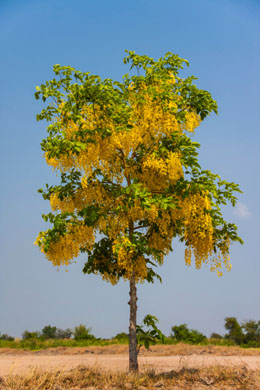The beautiful yellow cascade of cassia flowers will enchant you long after they fade away. This informative Buzzle article tells you all you need to know about it, and also provides tips on taking care of the plant.

The cassia tree, more popularly known as the golden shower tree, is native to tropical Asia. It is a flowering plant belonging to the family
Fabaceae, and botanically known as
Cassia fistula L. It has a rich background of being used in the preparation of Ayurvedic medicines. In Sanskrit, it is referred to as
aragvadha, which literally means disease killer. The tree and its parts are used for many medicinal purposes. It also has the honor of being declared as the national tree of Thailand.
Description
A widely grown ornamental tree, cassia is a medium-sized tree growing between 10 - 20 m tall. This fast grower is deciduous in nature. The leaves are long, about 20 - 60 cm, with each pinnate having a minimum 6 - 8 leaflets. It's the beautiful bright sunny yellow flowers, the cassia bears that has caught the attention of landscapers around the world. Every spring this tree bursts out with profusely flowering pendulous racemes measuring 20 - 40 cm. Each raceme has about a hundred, five-petalled flowers that open slowly, prolonging the flowering period. It bears fruits that contain several poisonous seeds, and has a typical pungent odor.
Care
The cassia tree is tolerant of most soils, but prefers moist and well drained ones. It requires full sunlight for blooming, and the flower colors to come true. The tree is primarily propagated through seeds and graft methods. Before germinating the cassia seed, a word on how to go about it. A dried seed is generally dormant, and the seed coat is impervious to water and gases required to kick start the germination process. A cassia seed has a very hard coat that needs to be broken for germination, hence, it is essential that the seed coat be altered physically.
Nature has its own way of doing so, like it being passed through the digestive tract of various animals, or some microbial activities, but that takes quite a bit if time. So, most commercial growers resort to scarification; a process of breaking or scratching the seed coat to allow penetration of water and gases. So if you have collected healthy seeds, soak them up in concentrated sulfuric acid for a couple of hours. The soaking duration depends upon the species. Wash the seed thoroughly, and soak in water for 24 hours before sowing. This 24-hour sowing will break the inner dormancy. Sow in a pot/s using the sowing medium.
Once your seed has germinated and reached a six leaf stage, it's time to plant the cassia sapling. Dig a hole deep enough to bury the entire root ball in it. The cassia tree's soil pH requirements are between the range 6.6 to 7.5. The soil should be neutral. Prepare the soil by mixing part soil, part compost, and part peat moss. Gently place the plant in the hole, and press it down. Back-fill the hole, and create a circular mound around it to prevent the water from draining out. Water the sapling lightly and well, until it begins to establish itself. Cassias aren't fussy, once they are well established. To protect the young tree from frost, resort to mulching around trees. Water as per climatic requirements. Fertilize the tree before the commencement of the flowering season to get a good flower show. Consider pruning to remove all dead and diseased wood. Cassia is very resistant to pests and diseases.
Although cassia is used medicinally, it is not safe to consume any part of this tree directly, probably the reason why it is grown more in public spaces than private gardens.






 The cassia tree, more popularly known as the golden shower tree, is native to tropical Asia. It is a flowering plant belonging to the family Fabaceae, and botanically known as Cassia fistula L. It has a rich background of being used in the preparation of Ayurvedic medicines. In Sanskrit, it is referred to as aragvadha, which literally means disease killer. The tree and its parts are used for many medicinal purposes. It also has the honor of being declared as the national tree of Thailand.
The cassia tree, more popularly known as the golden shower tree, is native to tropical Asia. It is a flowering plant belonging to the family Fabaceae, and botanically known as Cassia fistula L. It has a rich background of being used in the preparation of Ayurvedic medicines. In Sanskrit, it is referred to as aragvadha, which literally means disease killer. The tree and its parts are used for many medicinal purposes. It also has the honor of being declared as the national tree of Thailand.